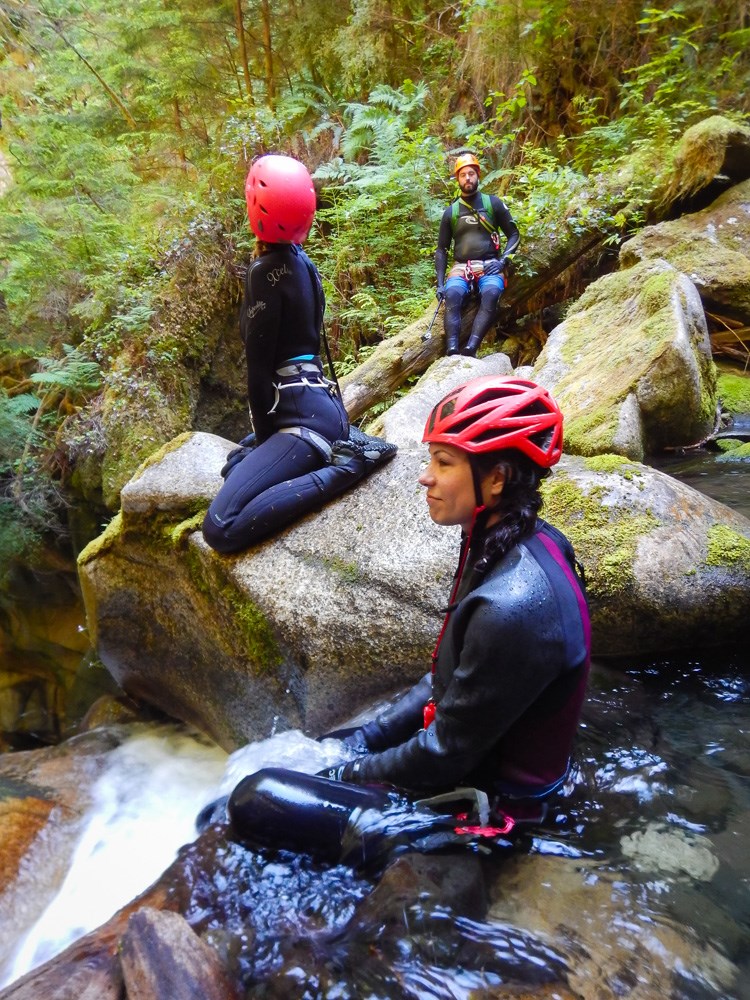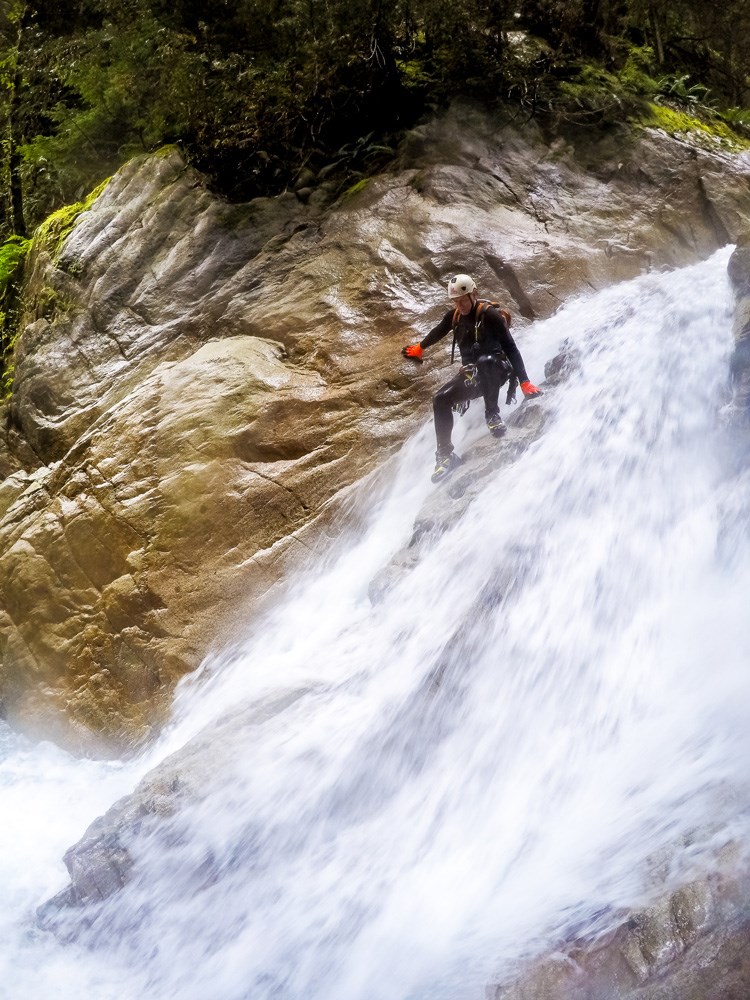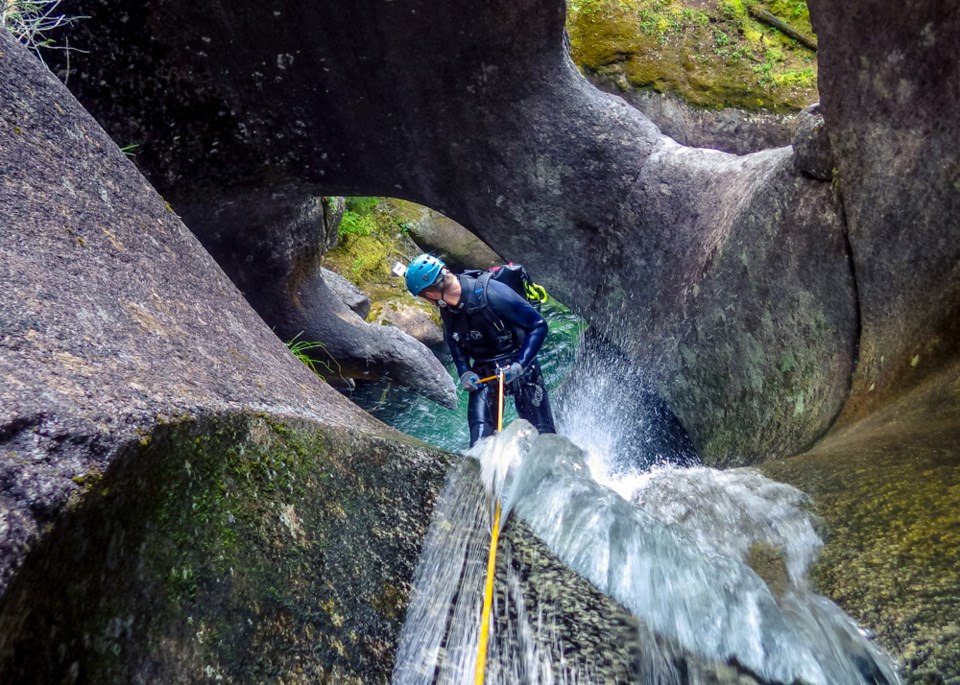When was the last time you felt true exhilaration? When your body is completely alive, your eyes wide and aware and all of your senses firing at 100 per cent.
Moments into my first canyoning descent near Squamish, this is exactly what I was feeling.
On the outside, this sport, especially near �鶹�����where most of the canyons are wet, can seem contrived. You don a mix of gear from other activities: a wetsuit from surfing, helmets and harnesses from rock climbing, some ropes and systems from caving, and then, finally, throw on a pair of old board shorts to protect the butt of your wetsuit from the coarse �鶹�����granite, and away you go!
A day out canyoning, also known as canyoneering or “gorge walking,” will usually look like this: first hike up beside the canyon and waterfalls and then scramble, rappel and jump your way down beside them until you get back to where you started, and that’s pretty much it.
What is left out, and what is difficult to communicate in words or imagery is the feeling of being in these places — an environment where humans cannot stay for long.

The cacophony of sound created by the crashing water echoing off the slick, polished canyon walls is a constant reminder that you need to keep moving to get out. Like climbing up high to visit a remote windswept summit in winter, you are constantly aware that your moments here are fleeting.
From the start, your senses are stimulated.
Once you enter the creek and canyon, your wetsuit fills with the bitterly cold water before it warms up to your body heat. All around you the water pushes you to keep moving downstream. Above, you can see the water history carved over eons to sculpt these places. Polished granite and basalt with the previous courses that the river flowed millenniums ago are visible in the canyon walls. The air is sweet with the smell of the mosses around you.
Frequently, the rush of the water will pull down scents from the forest above as well as a warm summer breeze in this otherwise cold and dark place.
Approaching the precipice at the top of each waterfall or drop in the canyon is engaging. Sometimes jumping down to the pool below is possible and always thrilling. Sometimes you rig up ropes off of logs jammed in the canyon or bolts that have been placed to allow for a safe descent.
A lot of times, you throw your backpack down ahead of you and then descend down after it.
Once on rappel, the feeling of being near or inside the waterfall is intense. The water pulls you down, pushing you to not stop until you are at the bottom. It is loud beyond belief and for this reason, you carry whistles to communicate. Once in the pool at the base, you free yourself from the rope and then signal for the next individual to follow.
You repeat this until you have either descended as far as you can go, or you have run out of daylight and need to exit the canyon. For the canyons near Squamish, the exit points can be few, so at each one a group will usually discuss how everyone is feeling and if they should continue past it.
While fairly new to Squamish, canyoning has been a popular activity for quite a while around the world. It is well developed in Europe and in places like Moab in the United States, exploring the dry, desert canyons is commonplace. Exploration of our canyons here in B.C., however, has been a fairly recent development. The season for adventuring down them safely can be short, depending on how long it takes for the water levels to drop after the winter snows have melted back.
It is so nascent, in fact, that a canyon within the boundaries of �鶹�����was first discovered and descended as recently as 2013. B.C. is a special place for this activity, as there is still so much left to discover. The rugged nature and lush rainforest lends itself well to an activity that, at its heart, is about exploration. Only a small portion of the canyons in our province have seen first descents. In recent years, I was personally able to accompany a party when they did the first exploration of a canyon that ended right beside the Sea to Sky Highway, just south of Squamish. It had been known about for years, but it is only now that individuals in the canyoning community have the knowledge and motivation to explore these places to their depths.
While there are currently no opportunities to be guided down the canyons near Squamish, there is a highly motivated group of individuals here that is excited to foster community and a love for the sport in others. Research “Vancouver canyoning” to find out more. They have a fairly active user group on Facebook.
Just remember that this is a sport like rock climbing or river kayaking and demands a confidence in wild environments and your full attention.
You should already be familiar with rope systems, rappelling and swimming in cold water in a wetsuit.
For ideas on where to go, consider the locations that follow. After each winter and spring, melt off the snow creep and debris that is washed downstream can damage the anchors, so it is strongly recommended that you only visit these locations with others that have been there before and who know about the difficulties and if the current conditions are safe.

Leigh and Spring McClurg
Box Canyon: Across the �鶹�����river and below Echo Lake is this stunning canyon just to the south of Monmouth Canyon. It features eight rappels near or in waterfalls up to a length of 30 metres. Expect to be in this canyon all day. On your right hand side will be beautifully sculpted basalt and on the left is pristine white granite.
Monmouth Canyon: Visible from downtown and also known locally as “Jump For Joy” Falls. It follows alongside the trail to Echo Lake and is just north of Box Canyon.
This descent is a serious undertaking, but thankfully has a few early exit points if your party is not moving efficiently enough to complete it. It features 16 rappels up to 45 metres in length. It does not have the tight canyon feel of Box, but the sheer height of the waterfalls and variety of sculpted rock make this an amazing place to visit.
Britannia Creek: The condition of this descent is in flux at the moment. Work is actively being done to return the creek to its original state, as a dam was built in it while the copper mine was active.
It is, however, the easiest creek near �鶹�����to descend as you can both drive to the bottom of it and then also shuttle a car to the top. With safe water levels, this creek has between four to seven rappels, three of them being optional jumps if the pools below are clear. There are additional opportunities to jump into pools to get around short drops also.
To conclude, always remember that these canyons are uncontrolled environments. Treat them with respect and always put safety first. If you do venture out to see them, have the time of your life! It will be an experience you will never forget.




